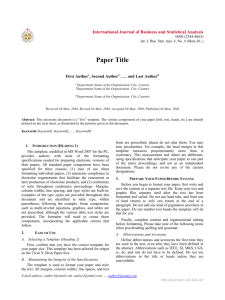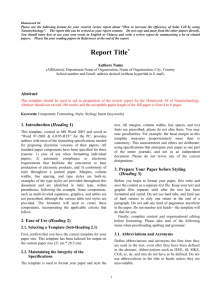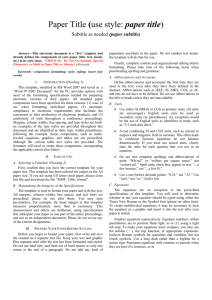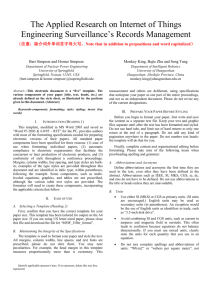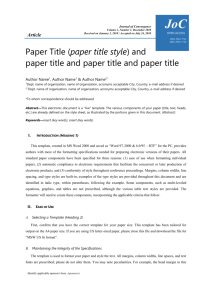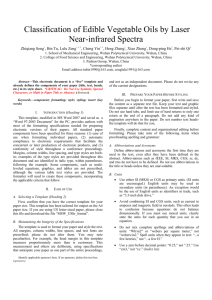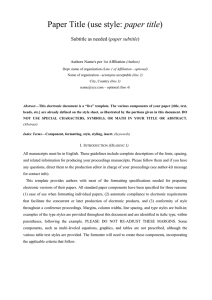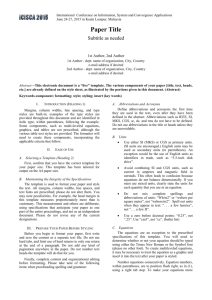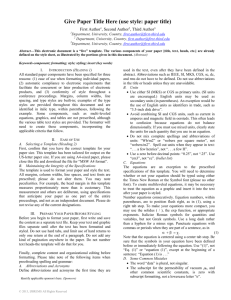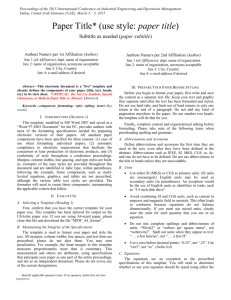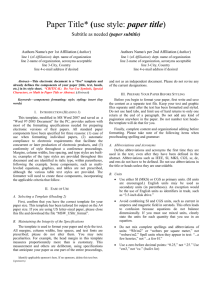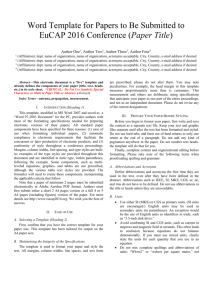IJBMTE template - Scientific Publishing Center Home
advertisement
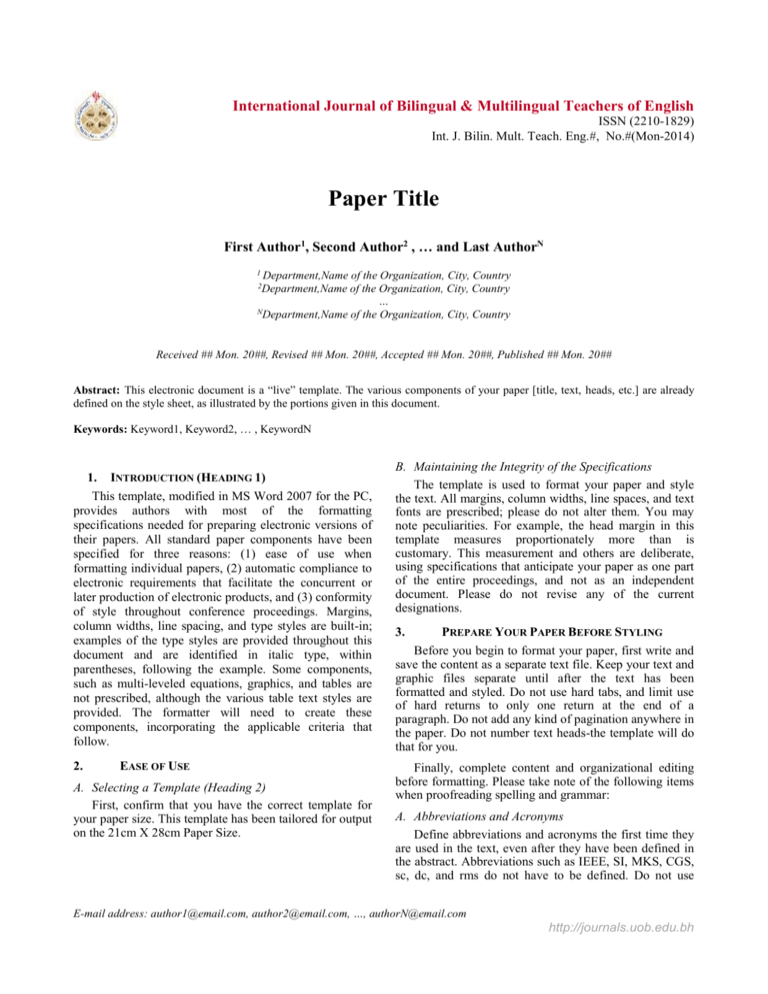
International Journal of Bilingual & Multilingual Teachers of English
ISSN (2210-1829)
Int. J. Bilin. Mult. Teach. Eng.#, No.#(Mon-2014)
Paper Title
First Author1, Second Author2 , … and Last AuthorN
1 Department,Name
of the Organization, City, Country
of the Organization, City, Country
…
NDepartment,Name of the Organization, City, Country
2Department,Name
Received ## Mon. 20##, Revised ## Mon. 20##, Accepted ## Mon. 20##, Published ## Mon. 20##
Abstract: This electronic document is a “live” template. The various components of your paper [title, text, heads, etc.] are already
defined on the style sheet, as illustrated by the portions given in this document.
Keywords: Keyword1, Keyword2, … , KeywordN
1.
INTRODUCTION (HEADING 1)
This template, modified in MS Word 2007 for the PC,
provides authors with most of the formatting
specifications needed for preparing electronic versions of
their papers. All standard paper components have been
specified for three reasons: (1) ease of use when
formatting individual papers, (2) automatic compliance to
electronic requirements that facilitate the concurrent or
later production of electronic products, and (3) conformity
of style throughout conference proceedings. Margins,
column widths, line spacing, and type styles are built-in;
examples of the type styles are provided throughout this
document and are identified in italic type, within
parentheses, following the example. Some components,
such as multi-leveled equations, graphics, and tables are
not prescribed, although the various table text styles are
provided. The formatter will need to create these
components, incorporating the applicable criteria that
follow.
2.
EASE OF USE
A. Selecting a Template (Heading 2)
First, confirm that you have the correct template for
your paper size. This template has been tailored for output
on the 21cm X 28cm Paper Size.
B. Maintaining the Integrity of the Specifications
The template is used to format your paper and style
the text. All margins, column widths, line spaces, and text
fonts are prescribed; please do not alter them. You may
note peculiarities. For example, the head margin in this
template measures proportionately more than is
customary. This measurement and others are deliberate,
using specifications that anticipate your paper as one part
of the entire proceedings, and not as an independent
document. Please do not revise any of the current
designations.
3.
PREPARE YOUR PAPER BEFORE STYLING
Before you begin to format your paper, first write and
save the content as a separate text file. Keep your text and
graphic files separate until after the text has been
formatted and styled. Do not use hard tabs, and limit use
of hard returns to only one return at the end of a
paragraph. Do not add any kind of pagination anywhere in
the paper. Do not number text heads-the template will do
that for you.
Finally, complete content and organizational editing
before formatting. Please take note of the following items
when proofreading spelling and grammar:
A. Abbreviations and Acronyms
Define abbreviations and acronyms the first time they
are used in the text, even after they have been defined in
the abstract. Abbreviations such as IEEE, SI, MKS, CGS,
sc, dc, and rms do not have to be defined. Do not use
E-mail address: author1@email.com, author2@email.com, …, authorN@email.com
http://journals.uob.edu.bh
Author Name: Paper Title …
2
abbreviations in the title or heads unless they are
unavoidable.
with subscript formatting, not a lowercase letter
“o”.
B. Units
Use either SI (MKS) or CGS as primary units. (SI
units are encouraged.) English units may be used
as secondary units (in parentheses). An exception
would be the use of English units as identifiers in
trade, such as “3.5-inch disk drive”.
In American English, commas, semi-/colons,
periods, question and exclamation marks are
located within quotation marks only when a
complete thought or name is cited, such as a title
or full quotation. When quotation marks are used,
instead of a bold or italic typeface, to highlight a
word or phrase, punctuation should appear
outside of the quotation marks. A parenthetical
phrase or statement at the end of a sentence is
punctuated outside of the closing parenthesis (like
this). (A parenthetical sentence is punctuated
within the parentheses.)
Avoid combining SI and CGS units, such as
current in amperes and magnetic field in oersteds.
This often leads to confusion because equations
do not balance dimensionally. If you must use
mixed units, clearly state the units for each
quantity that you use in an equation.
Do not mix complete spellings and abbreviations
of units: “Wb/m2” or “webers per square meter”,
not “webers/m2”. Spell out units when they
appear in text: “. . . a few henries”, not “. . . a few
H”.
A graph within a graph is an “inset”, not an
“insert”. The word alternatively is preferred to the
word “alternately” (unless you really mean
something that alternates).
Use a zero before decimal points: “0.25”, not
“.25”. Use “cm3”, not “cc”. (bullet list)
Do not use the word “essentially” to mean
“approximately” or “effectively”.
In your paper title, if the words “that uses” can
accurately replace the word “using”, capitalize the
“u”; if not, keep using lower-cased.
Be aware of the different meanings of the
homophones “affect” and “effect”, “complement”
and “compliment”, “discreet” and “discrete”,
“principal” and “principle”.
Do not confuse “imply” and “infer”.
The prefix “non” is not a word; it should be
joined to the word it modifies, usually without a
hyphen.
There is no period after the “et” in the Latin
abbreviation “et al.”.
The abbreviation “i.e.” means “that is”, and the
abbreviation “e.g.” means “for example”.
C. Equations
The equations are an exception to the prescribed
specifications of this template. You will need to determine
whether or not your equation should be typed using either
the Times New Roman or the Symbol font (please no
other font). To create multileveled equations, it may be
necessary to treat the equation as a graphic and insert it
into the text after your paper is styled.
Number equations consecutively. Equation numbers,
within parentheses, are to position flush right, as in (1),
using a right tab stop. To make your equations more
compact, you may use the solidus ( / ), the exp function,
or appropriate exponents. Italicize Roman symbols for
quantities and variables, but not Greek symbols. Use a
long dash rather than a hyphen for a minus sign.
Punctuate equations with commas or periods when they
are part of a sentence, as in
Note that the equation is centered using a center tab
stop. Be sure that the symbols in your equation have been
defined before or immediately following the equation.
Use “(1)”, not “Eq. (1)” or “equation (1)”, except at the
beginning of a sentence: “Equation (1) is . . .”
D. Some Common Mistakes
The word “data” is plural, not singular.
and other common scientific constants, is zero
An excellent style manual for science writers is [7].
4.
USING THE TEMPLATE
After the text edit has been completed, the paper is
ready for the template. Duplicate the template file by
using the Save As command, and use the naming
convention prescribed by your conference for the name of
your paper. In this newly created file, highlight all of the
contents and import your prepared text file. You are now
ready to style your paper; use the scroll down window on
the left of the MS Word Formatting toolbar.
A. Authors and Affiliations
The template is designed so that author affiliations are
not repeated each time for multiple authors of the same
affiliation. Please keep your affiliations as succinct as
http://journals.uob.edu.bh
Int. J. Bilin. Mult. Teach. Eng.#, No.# , ##-## (Mon-2014)
3
possible (for example, do not differentiate among
departments of the same organization). This template was
designed for two affiliations.
at least two sub-topics, then no subheads should be
introduced. Styles named “Heading 1”, “Heading 2”,
“Heading 3”, and “Heading 4” are prescribed.
1) For author/s of only one affiliation (Heading 3):
To change the default, adjust the template as follows.
a) Selection (Heading 4): Highlight all author and
affiliation lines.
b) Change number of columns: Select the Columns
icon from the MS Word Standard toolbar and then select
“1 Column” from the selection palette.
c) Deletion: Delete the author and affiliation lines
for the second affiliation.
d) For author/s of more than two affiliations: To
change the default, adjust the template as follows.
e) Selection: Highlight all author and affiliation
lines.
f) Change number of columns: Select the
“Columns” icon from the MS Word Standard toolbar and
then select “1 Column” from the selection palette.
g) Highlight author and affiliation lines of
affiliation 1 and copy this selection.
h) Formatting: Insert one hard return immediately
after the last character of the last affiliation line. Then
paste down the copy of affiliation 1. Repeat as necessary
for each additional affiliation.
i) Reassign number of columns: Place your cursor
to the right of the last character of the last affiliation line
of an even numbered affiliation (e.g., if there are five
affiliations, place your cursor at end of fourth affiliation).
Drag the cursor up to highlight all of the above author and
affiliation lines. Go to Column icon and select “2
Columns”. If you have an odd number of affiliations, the
final affiliation will be centered on the page; all previous
will be in two columns.
C. Figures and Tables
1) Positioning Figures and Tables: Place figures and
tables at the top and bottom of columns. Avoid placing
them in the middle of columns. Large figures and tables
may span across both columns. Figure captions should be
below the figures; table heads should appear above the
tables. Insert figures and tables after they are cited in the
text. Use the abbreviation “Fig. 1”, even at the beginning
of a sentence.
TABLE I.
Table
Head
TABLE TYPE STYLES
Table Column Head
Table column subhead
Subhead
Subhead
We suggest that you use a text box to insert a
graphic (which is ideally a 300 dpi TIFF or EPS file,
with all fonts embedded) because, in an MSW
document, this method is somewhat more stable
than directly inserting a picture.
To have non-visible rules on your frame, use the
MSWord “Format” pull-down menu, select Text
Box > Colors anda Lines to choose No Fill and No
copy
Line.More table copy
a. Sample of a Table footnote. (Table footnote)
Figure 1. Example of a figure caption. (figure caption)
B. Identify the Headings
Headings, or heads, are organizational devices that
guide the reader through your paper. There are two types:
component heads and text heads.
Figure Labels: Use 8 point Times New Roman for
Figure labels. Use words rather than symbols or
abbreviations when writing Figure axis labels to avoid
confusing the reader. As an example, write the quantity
“Magnetization”, or “Magnetization, M”, not just “M”. If
including units in the label, present them within
parentheses. Do not label axes only with units. In the
example, write “Magnetization (A/m)” or “Magnetization
{A[m(1)]}”, not just “A/m”. Do not label axes with a ratio
of quantities and units. For example, write “Temperature
(K)”, not “Temperature/K”.
Component heads identify the different components of
your paper and are not topically subordinate to each other.
Use “figure caption” for your Figure captions, and “table
head” for your table title. Run-in heads, such as
“Abstract”, will require you to apply a style (in this case,
italic) in addition to the style provided by the drop down
menu to differentiate the head from the text.
ACKNOWLEDGMENT
The preferred spelling of the word “acknowledgment”
in America is without an “e” after the “g”. Avoid the
stilted expression, “One of us (R. B. G.) thanks . . .”
Instead, try “R. B. G. thanks”. Put sponsor
acknowledgments in the unnum-bered footnote on the
first page.
Text heads organize the topics on a relational,
hierarchical basis. For example, the paper title is the
primary text head because all subsequent material relates
and elaborates on this one topic. If there are two or more
sub-topics, the next level head (uppercase Roman
numerals) should be used and, conversely, if there are not
REFERENCES
APA style should be followed with citation.
Al-Khalili, K. Y. (2012). Impact of training workshops on creation
and adoption of new electronic scientific journals. The Online Journal
of New Horizons in Education TOJNED,2 (3), 16-24.
http://journals.uob.edu.bh
4
Author Name: Paper Title …
Bar-Ilan, J. (2008). Which h-index? – A comparison of WoS, Scopus
and Google Scholar. Budapest Scientometrics, 74( 2),257–271and
Springer, Dordrecht DOI: 10.1007/s11192-008-0216-y
Cameron, B. D. (2005). Trends in the usage of ISI bibliometric data:
Uses, abuses, and implications. Libraries and the Academy, 5(1), 105125. (ERIC Document Reproduction Service No. EJ 792746).
Haslam, N. (2012). Impact, "H", and authorship. Measurement:
Interdisciplinary Research and Perspectives, 10(3), 161-163 2012.
(ERIC Document Reproduction Service No. EJ993910).
Heider, K., Laverick, D., & Bennett, B. (2009). Digital textbooks:
The next paradigm shift in Higher Education? AACE Journal, 17 (2)
103-112.(ERIC Document Reproduction Service No. EJ853401).
http://journals.uob.edu.bh
